snow chains FIAT DOBLO COMBI 2015 2.G Owners Manual
[x] Cancel search | Manufacturer: FIAT, Model Year: 2015, Model line: DOBLO COMBI, Model: FIAT DOBLO COMBI 2015 2.GPages: 323, PDF Size: 46.77 MB
Page 118 of 323
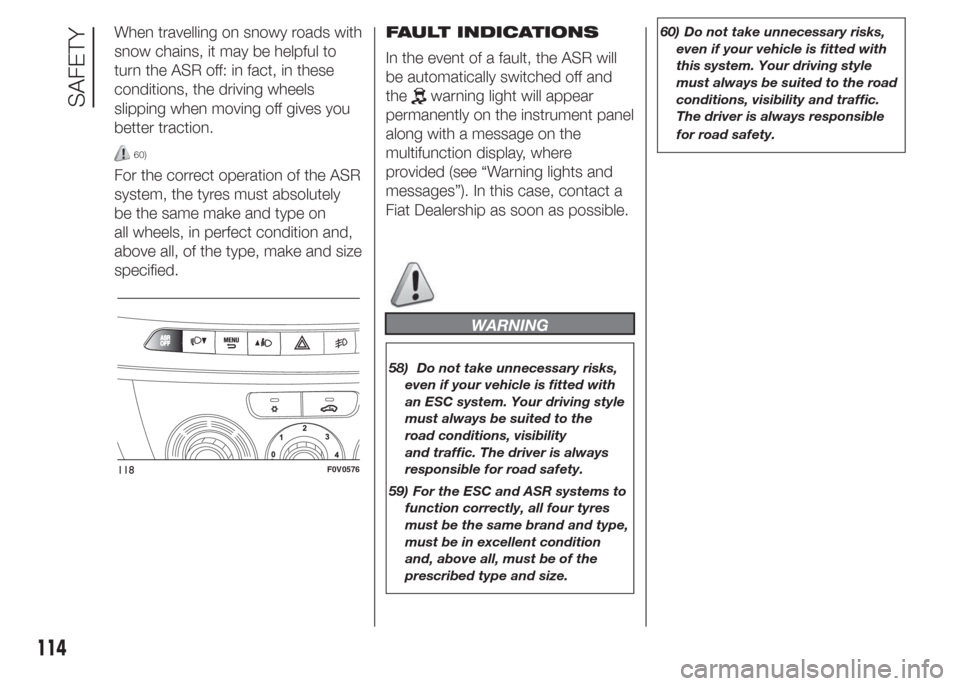
When travelling on snowy roads with
snow chains, it may be helpful to
turn the ASR off: in fact, in these
conditions, the driving wheels
slipping when moving off gives you
better traction.
60)
For the correct operation of the ASR
system, the tyres must absolutely
be the same make and type on
all wheels, in perfect condition and,
above all, of the type, make and size
specified.FAULT INDICATIONS
In the event of a fault, the ASR will
be automatically switched off and
the
warning light will appear
permanently on the instrument panel
along with a message on the
multifunction display, where
provided (see “Warning lights and
messages”). In this case, contact a
Fiat Dealership as soon as possible.
WARNING
58) Do not take unnecessary risks,
even if your vehicle is fitted with
an ESC system. Your driving style
must always be suited to the
road conditions, visibility
and traffic. The driver is always
responsible for road safety.
59) For the ESC and ASR systems to
function correctly, all four tyres
must be the same brand and type,
must be in excellent condition
and, above all, must be of the
prescribed type and size.60) Do not take unnecessary risks,
even if your vehicle is fitted with
this system. Your driving style
must always be suited to the road
conditions, visibility and traffic.
The driver is always responsible
for road safety.
118F0V0576
114
SAFETY
Page 139 of 323
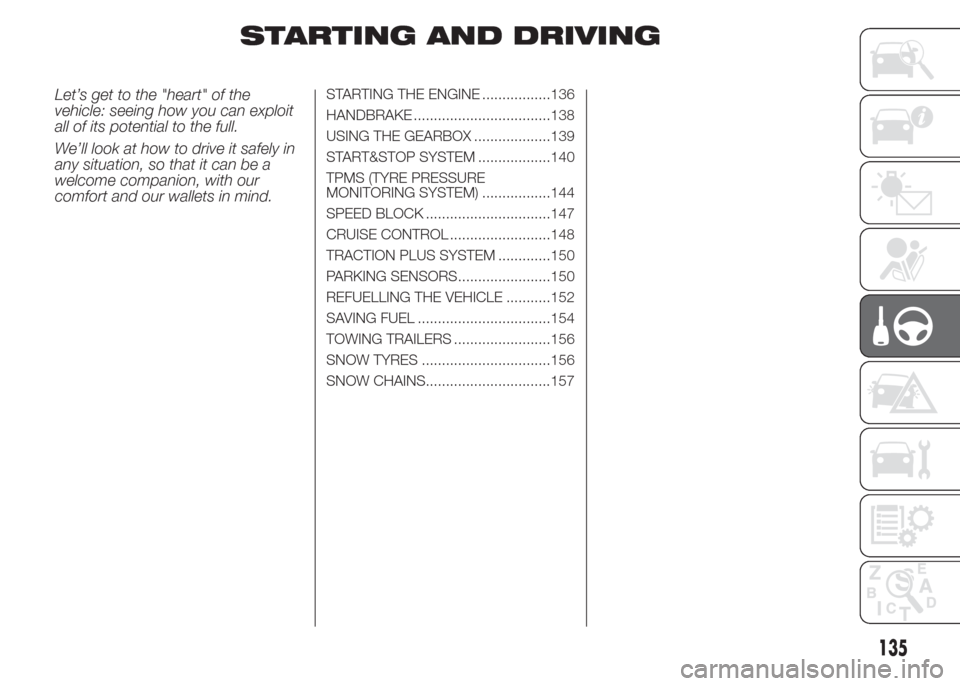
STARTING AND DRIVING
Let’s get to the "heart" of the
vehicle: seeing how you can exploit
all of its potential to the full.
We’ll look at how to drive it safely in
any situation, so that it can be a
welcome companion, with our
comfort and our wallets in mind.STARTING THE ENGINE .................136
HANDBRAKE ..................................138
USING THE GEARBOX ...................139
START&STOP SYSTEM ..................140
TPMS (TYRE PRESSURE
MONITORING SYSTEM) .................144
SPEED BLOCK ...............................147
CRUISE CONTROL .........................148
TRACTION PLUS SYSTEM .............150
PARKING SENSORS.......................150
REFUELLING THE VEHICLE ...........152
SAVING FUEL .................................154
TOWING TRAILERS ........................156
SNOW TYRES ................................156
SNOW CHAINS...............................157
135
Page 149 of 323
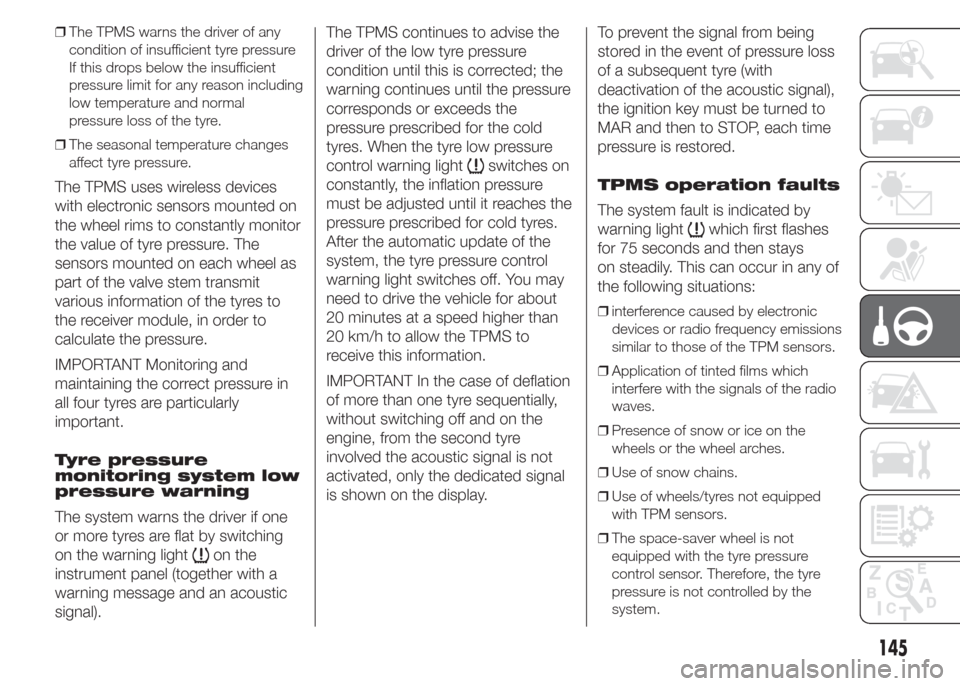
❒The TPMS warns the driver of any
condition of insufficient tyre pressure
If this drops below the insufficient
pressure limit for any reason including
low temperature and normal
pressure loss of the tyre.
❒The seasonal temperature changes
affect tyre pressure.
The TPMS uses wireless devices
with electronic sensors mounted on
the wheel rims to constantly monitor
the value of tyre pressure. The
sensors mounted on each wheel as
part of the valve stem transmit
various information of the tyres to
the receiver module, in order to
calculate the pressure.
IMPORTANT Monitoring and
maintaining the correct pressure in
all four tyres are particularly
important.
Tyre pressure
monitoring system low
pressure warning
The system warns the driver if one
or more tyres are flat by switching
on the warning light
on the
instrument panel (together with a
warning message and an acoustic
signal).The TPMS continues to advise the
driver of the low tyre pressure
condition until this is corrected; the
warning continues until the pressure
corresponds or exceeds the
pressure prescribed for the cold
tyres. When the tyre low pressure
control warning light
switches on
constantly, the inflation pressure
must be adjusted until it reaches the
pressure prescribed for cold tyres.
After the automatic update of the
system, the tyre pressure control
warning light switches off. You may
need to drive the vehicle for about
20 minutes at a speed higher than
20 km/h to allow the TPMS to
receive this information.
IMPORTANT In the case of deflation
of more than one tyre sequentially,
without switching off and on the
engine, from the second tyre
involved the acoustic signal is not
activated, only the dedicated signal
is shown on the display.To prevent the signal from being
stored in the event of pressure loss
of a subsequent tyre (with
deactivation of the acoustic signal),
the ignition key must be turned to
MAR and then to STOP, each time
pressure is restored.
TPMS operation faults
The system fault is indicated by
warning light
which first flashes
for 75 seconds and then stays
on steadily. This can occur in any of
the following situations:
❒interference caused by electronic
devices or radio frequency emissions
similar to those of the TPM sensors.
❒Application of tinted films which
interfere with the signals of the radio
waves.
❒Presence of snow or ice on the
wheels or the wheel arches.
❒Use of snow chains.
❒Use of wheels/tyres not equipped
with TPM sensors.
❒The space-saver wheel is not
equipped with the tyre pressure
control sensor. Therefore, the tyre
pressure is not controlled by the
system.
145
Page 161 of 323
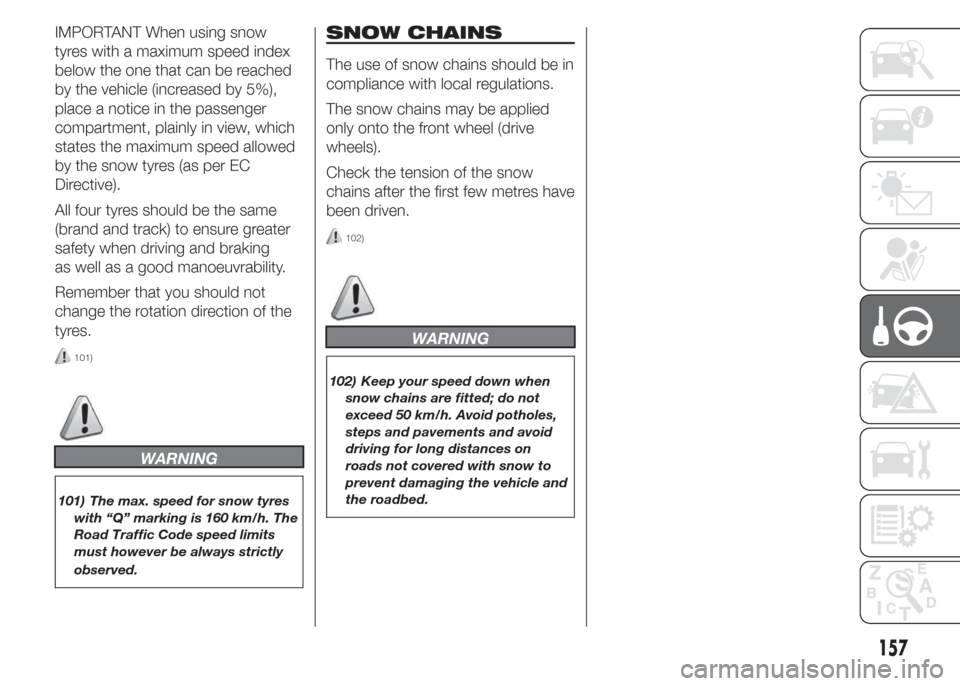
IMPORTANT When using snow
tyres with a maximum speed index
below the one that can be reached
by the vehicle (increased by 5%),
place a notice in the passenger
compartment, plainly in view, which
states the maximum speed allowed
by the snow tyres (as per EC
Directive).
All four tyres should be the same
(brand and track) to ensure greater
safety when driving and braking
as well as a good manoeuvrability.
Remember that you should not
change the rotation direction of the
tyres.
101)
WARNING
101) The max. speed for snow tyres
with “Q” marking is 160 km/h. The
Road Traffic Code speed limits
must however be always strictly
observed.
SNOW CHAINS
The use of snow chains should be in
compliance with local regulations.
The snow chains may be applied
only onto the front wheel (drive
wheels).
Check the tension of the snow
chains after the first few metres have
been driven.
102)
WARNING
102) Keep your speed down when
snow chains are fitted; do not
exceed 50 km/h. Avoid potholes,
steps and pavements and avoid
driving for long distances on
roads not covered with snow to
prevent damaging the vehicle and
the roadbed.
157
Page 321 of 323
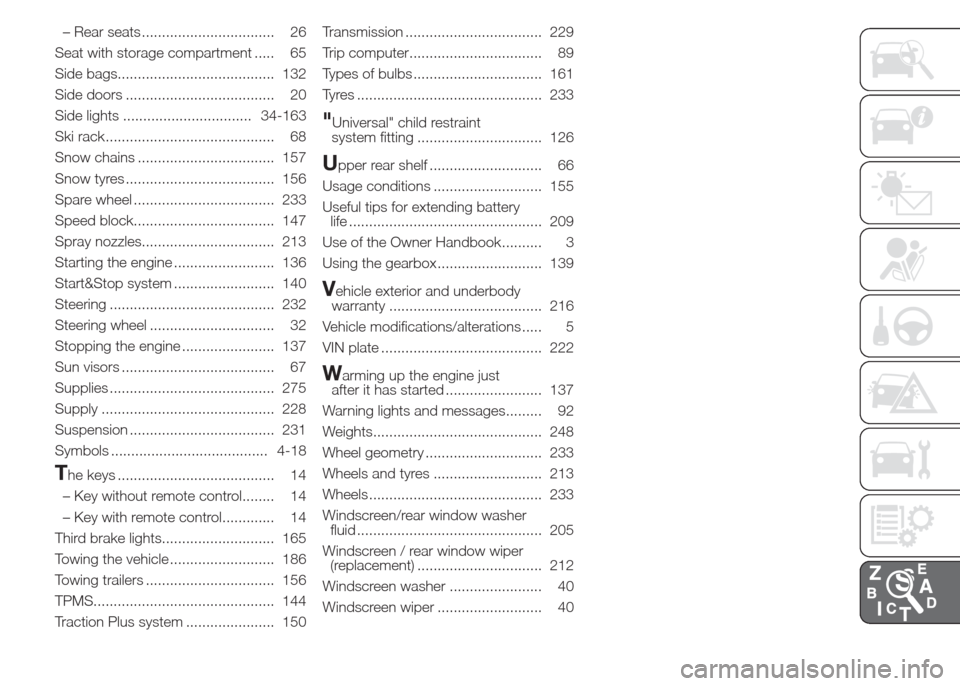
– Rear seats ................................. 26
Seat with storage compartment ..... 65
Side bags....................................... 132
Side doors ..................................... 20
Side lights ................................ 34-163
Ski rack.......................................... 68
Snow chains .................................. 157
Snow tyres ..................................... 156
Spare wheel ................................... 233
Speed block................................... 147
Spray nozzles................................. 213
Starting the engine ......................... 136
Start&Stop system ......................... 140
Steering ......................................... 232
Steering wheel ............................... 32
Stopping the engine ....................... 137
Sun visors ...................................... 67
Supplies ......................................... 275
Supply ........................................... 228
Suspension .................................... 231
Symbols ....................................... 4-18
The keys ....................................... 14
– Key without remote control........ 14
– Key with remote control............. 14
Third brake lights............................ 165
Towing the vehicle .......................... 186
Towing trailers ................................ 156
TPMS............................................. 144
Traction Plus system ...................... 150Transmission .................................. 229
Trip computer................................. 89
Types of bulbs ................................ 161
Tyres .............................................. 233
"Universal" child restraint
system fitting ............................... 126
Upper rear shelf ............................ 66
Usage conditions ........................... 155
Useful tips for extending battery
life ................................................ 209
Use of the Owner Handbook.......... 3
Using the gearbox .......................... 139
Vehicle exterior and underbody
warranty ...................................... 216
Vehicle modifications/alterations ..... 5
VIN plate ........................................ 222
Warming up the engine just
after it has started ........................ 137
Warning lights and messages......... 92
Weights.......................................... 248
Wheel geometry ............................. 233
Wheels and tyres ........................... 213
Wheels ........................................... 233
Windscreen/rear window washer
fluid .............................................. 205
Windscreen / rear window wiper
(replacement) ............................... 212
Windscreen washer ....................... 40
Windscreen wiper .......................... 40